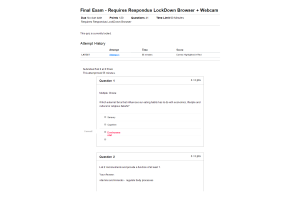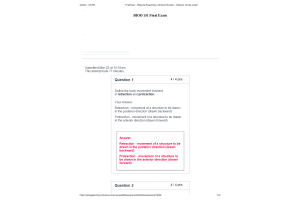NURS 231 Final Exam
Course : NURS 231 Pathophysiology
Contributed : Egreta Ston
- $45.00
- Question: Metaplastic cells are not better prepared to survive under stressful circumstances.
- Question: Hypertrophy can occur under normal and pathological conditions.
- Question: Which are true of the mitochondria? Select all that apply.
- Question: Which are true of the cell membrane? Select all that apply.
- Question: Compare and contrast the two types of gangrenous necrosis.
- Question: Cell proliferation is the process in which proliferating cells become more specialized cell types.
- Question: Cell differentiation is the process of increasing cell numbers by mitotic cell division.
- Question: What are two important properties that stem cells possess?
- Question: These are cells of the same lineage that have not yet differentiated to the extent that they have lost their ability to divide:
- Question: ______ is a systemic treatment that enables drugs to reach the site of the tumor as well as other distant sites. The profound weight loss and wasting of fat and tissue that accompany cancer is known as _______.
- Question: Explain the challenges of diagnosing autoimmune disorders.
- Question: The T cells that display the host’s MHC antigens and T-cell receptors for a nonself-antigen are allowed to mature, a process termed negative selection.
- Question: Which lab value will typically be increased in a viral infection?
- Question: A 9-year-old boy with a peanut allergy was exposed to peanuts. He presents to the emergency room with an anaphylactic reaction. (1) What symptoms might he present with? (2) Does the quantity of exposure mean he will have a more severe reaction? (3) What is the initial immediate treatment? (4) What are 2 things people with anaphylaxis should always carry?
- Question: A 23-year-old African-American man with a history of severe lifelong anemia requiring many transfusions has nonhealing leg ulcers and recurrent periods of abdominal and chest pain. These signs and symptoms are most likely to be associated with which one of the following laboratory abnormalities?
- Question: Which of the following is NOT true of vitamin B12 deficiency anemia?
- Question: Each of the following are risk factors for secondary hyperlipidemia except?
- Question: Risk factors for coronary heart disease include each of the following except:
- Question: Patient is found to have the above: 1. What risk factors mostly led to this disease state? 2. What is this person at risk for developing? 3. What lifestyle modifications would you suggest for them?
- Question: _____ is the transfer of gases between the alveoli and the pulmonary capillaries.
- Question: Each of the following can lead to atelectasis except:
- Question: A 10-year-old boy who is having an acute asthma attack is brought to the ER. He is observed to be sitting up and struggling to breathe. His breathing is accompanied by use of accessory muscles, a weak cough, and audible wheezing sounds. His pulse is rapid and weak, and both heart and breath sounds are distant on auscultation. His parents relate that his asthma began to worsen after he developed a “cold,” and now he doesn’t get relief from his albuterol inhaler. Explain the changes in physiologic function underlying his signs and symptoms.
- Question: Oligodendrocytes produce myelin in the PNS.
- Question: Someone in the early stages of Alzheimer’s disease requires assistance for their activities of daily living.
- Question: A 75-year-old male is brought to the emergency department via ambulance at 5 pm. The patient’s spouse reports that when they woke up (approximately at 6 am) he reported to her that he was having some blurred vision but decided to go about his day. As the day progressed, he started experiencing tingling and feelings of weakness on the entire left side of his body. He has a past medical history of diabetes. Based upon these symptoms and past medical history, what do you suspect this patient is experiencing? How would you confirm this diagnosis? What treatment should be administered? Explain why you chose that treatment.
- Question: Risk factors for gallstone formation include each of the following EXCEPT:
- Question: Risk factors for the development of peptic ulcer include each of the following EXCEPT:
- Question: What are rhythmic movements designed to propel the chyme along the small intestine toward the large intestine?
- Question: Anti-diarrheal medication can be used with all types of diarrhea.
- Question: Which of the following is characteristic of chronic transplant rejection?
- Question: A patient is said to be in stage 2 kidney disease. What would you expect their GFR to be?
- Question: Explain how the kidney can maintain a constant GFR despite variations in the arterial blood pressure of the rest of the body.
- Question: A patient presents in the emergency department with severe dehydration secondary to vomiting. The following are the results of their blood work: pH = 8.2, PCO2 = 39 mm, and HCO3 - = 33 mEq/L. Based upon these results, what type of acid-base disorder are they experiencing? Is compensation occurring? Describe a treatment intervention for this disorder. Normal values are as follows: pH = 7.35-7.45, PCO2 = 35-45 mm, HCO3 - = 22-26 mEq/L.
- Question: Signs and symptoms of Addison’s disease include each of the following EXCEPT:
- Question: An endocrine hormone is released into circulation to act on a target organ.
- Question: Hormones work through receptors, and the speed of this action varies.
- Question: A 45-year-old woman presents with fatigue, weight gain, and cold intolerance. Lab findings show a low serum T4 and elevated TSH. 1. What diagnosis would her history and lab findings indicate? 2. What type of treatment should be given?
- Question: Symptoms of diabetic ketoacidosis (DKA) include each of the following EXCEPT:
- Question: Which of the following would a patient likely report if you suspect they have OA?
- Question: Blood circulates through bone by what means? (mark all that apply)
- Question: If someone loses their balance when walking on uneven terrain, explain how tendons and ligaments work to protect the joint and structures within it.
- Question: A 72-year-old male is said to be in phase 3 of gout. He is obese and has a history of alcohol abuse. Develop a treatment plan including specific pharmacologic intervention and a nonpharmacologic recommendation to manage his disease.




